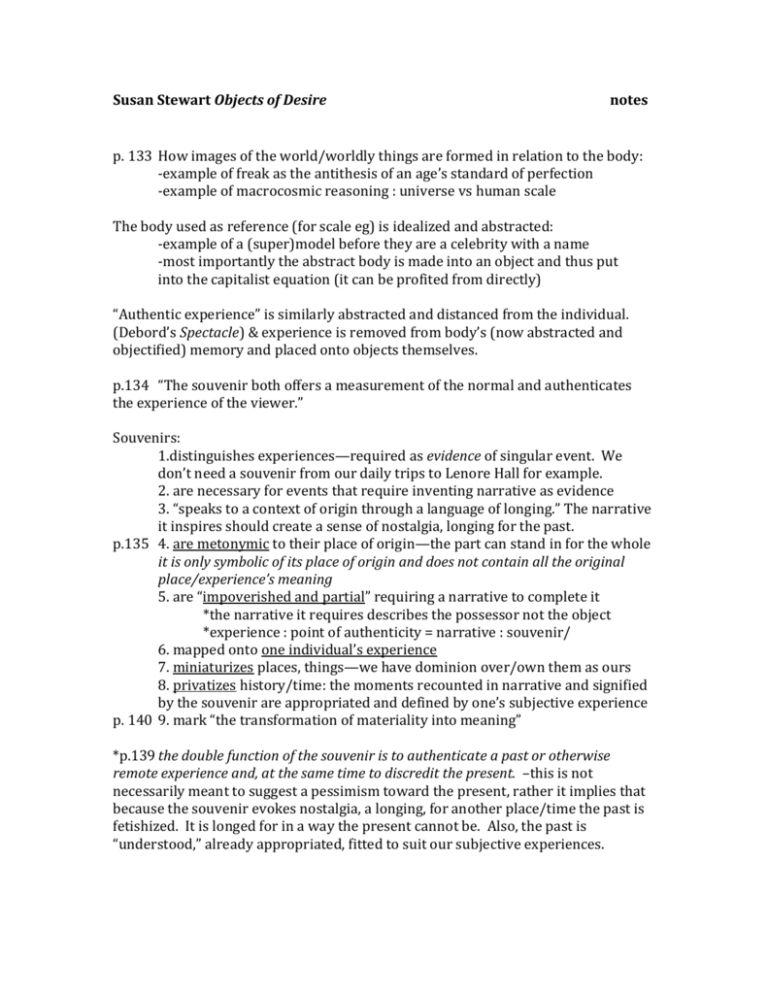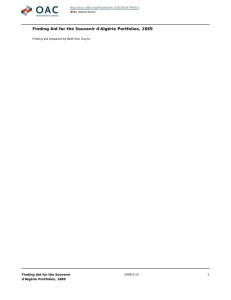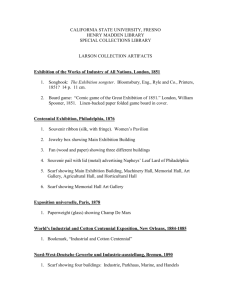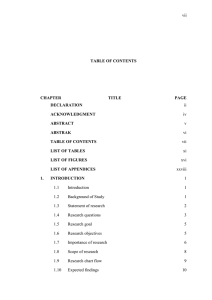Susan Stewart Objects of Desire notes
advertisement

Susan Stewart Objects of Desire
notes
p. 133 How images of the world/worldly things are formed in relation to the body:
-example of freak as the antithesis of an age’s standard of perfection
-example of macrocosmic reasoning : universe vs human scale
The body used as reference (for scale eg) is idealized and abstracted:
-example of a (super)model before they are a celebrity with a name
-most importantly the abstract body is made into an object and thus put
into the capitalist equation (it can be profited from directly)
“Authentic experience” is similarly abstracted and distanced from the individual.
(Debord’s Spectacle) & experience is removed from body’s (now abstracted and
objectified) memory and placed onto objects themselves.
p.134 “The souvenir both offers a measurement of the normal and authenticates
the experience of the viewer.”
Souvenirs:
1.distinguishes experiences—required as evidence of singular event. We
don’t need a souvenir from our daily trips to Lenore Hall for example.
2. are necessary for events that require inventing narrative as evidence
3. “speaks to a context of origin through a language of longing.” The narrative
it inspires should create a sense of nostalgia, longing for the past.
p.135 4. are metonymic to their place of origin—the part can stand in for the whole
it is only symbolic of its place of origin and does not contain all the original
place/experience’s meaning
5. are “impoverished and partial” requiring a narrative to complete it
*the narrative it requires describes the possessor not the object
*experience : point of authenticity = narrative : souvenir/
6. mapped onto one individual’s experience
7. miniaturizes places, things—we have dominion over/own them as ours
8. privatizes history/time: the moments recounted in narrative and signified
by the souvenir are appropriated and defined by one’s subjective experience
p. 140 9. mark “the transformation of materiality into meaning”
*p.139 the double function of the souvenir is to authenticate a past or otherwise
remote experience and, at the same time to discredit the present. –this is not
necessarily meant to suggest a pessimism toward the present, rather it implies that
because the souvenir evokes nostalgia, a longing, for another place/time the past is
fetishized. It is longed for in a way the present cannot be. Also, the past is
“understood,” already appropriated, fitted to suit our subjective experiences.
p. 142 : “In order to entertain an antiquarian (anthropologist’s) sensibility, a rupture
in historical consciousness must have occurred, creating a sense that one can make
one’s own culture other—distant and discontinuous.” Again, what is collected and
observed is othered, maintaining the dominant cultural norms as normal.
p. 143 : “(The antiquarian’s) search is primarily an aesthetic one, an attempt to
erase the actual past in order to create an imagined past which is available for
consumption. In order to awaken the dead, the antiquarian must first manage to kill
them” ...Lacan’s formulation
murder of a thing = disrupting past-present narrative means diminishing or
entirely erasing the significance of the thing in the present
symbol = dead object reduced to its historical significance. points to the
history/narrative not to the thing itself
Both the above quotes point to a necessary closing-off of historical continuity. The
past era is done and dead, now we can reinvest it with meaning through examining
its remains…the souvenir as artifact.
p. 146 : the necessary estrangements of objects. If we imagine that we have never
before seen a pencil, or let’s say a dot-matrix printer…in some future time when we
no longer use printed matter… we must then reinvent its significance to us in
relation to our understanding of the era from which it came. Say it came from our
grandfather’s basement, we attach meaning to this object through our own
experience—as it were plucked out of the collection of his things it was “of interest
to us,” and somehow spoke to our own experience.
149: “for the invention of the exotic object to take place, there must first be
separation…become tourists of their parents’ way of life…”
p.145 “childhood is not a childhood as lived; it is a childhood voluntarily
remembered, a childhood manufactured from its material survivals. Thus it is a
collage made of presents rather than a reawakening of the past... the past is
constructed from a set of presently existing pieces.. only the act of memory
constitutes their resemblance... (read remainder of graph...so beautiful!)
p. 146 “modern is cold and the antique and the exotic are warm because
contemporary mythology places the latter objects in a childhood remote from the
abstractions of contemporary consumer society (from first page of essay where
experience is abstracted and objectified). Such objects allow one to be a tourist of
one’s own life...”
p. 147 “to have a souvenir of the exotic is to possess both a specimen and a trophy;
on the one hand, the object must be marked as exterior and foreign, on the other it
must be marked as arising directly out of an immediate experience of its possessor.”
“there is a directly proportional relationship between the availability of the
exotic experience and the availability of ‘exotic objects.’” –the more readily available
the object, the less exotic it is, and the more ‘watered down’ the experience.
p. 149 When previously useful or culturally significant objects are (re)produced for
the sole purpose of souvenir/aesthetic value, they are emptied of “those qualities...
which link it to its function in native context.” They are valuable only in “the
symbolic system of the consumer (tourist).”
The Collection:
1. offers metaphor rather than metonymy
2. replaces history with classification—order/temporality specific to the set
3. Represents “the total aestheticization of use value.”
p. 153 4. Objects significance are only in relation to the collection (meaning is
severed from its origin) “The spatial whole of the collection supersedes the
individual narratives that lie behind it.”
5. governed by principles of organization (to create collection-specific
narrative)
6. Baudrillard’s conclusion that a “formal interest always replaces a real
interest” in collected objects—aesthetic value over use value
p. 155 7. difference: to group similar objects is to signify their difference
8. the collection narrates the collector’s history, illustrates their portrait
(example of Nichols p. 156)
9. evidence of production/object origins are replaced with the collector’s
“labor” in selecting and arranging.
...production is captured (found). “we are inheritors not producers of value”
10. containment / parameters = definitive narrative / portrait
p.163 11. “Desire is ordered arranged, manipulated, not fathomless as in the
nostalgia of the souvenir”
p.162 “When objects are defined in terms of their use value, they serve as
extensions of the body into the environment, but when objects are defined by the
collection, such an extension is inverted, serving to subsume the environment to a
scenario of the personal.” –explain?
quote from Marx & middle of page 165 “The souvenir magically transports us
to the scene of origin, but the collection is magically and serially transported to the
scene of acquisition, its proper destination...”
“...the collection is not only far removed from contexts of material
production; it is also the most abstract of all forms of consumption.”
{more complicated scenario…in acquiring a souvenir there is some appreciation for
the labor that went into making it, or at least acquiring it…where the collection
prizes the aesthetic of the object and its relation to the other objects in the
collection, and its connection to the collector’s biography over the innate history /
use value / production of the object itself.}
“The collector constructs a narrative of luck which replaces the narrative of
production.”











